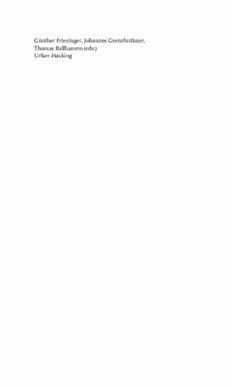
Urban Hacking: Cultural Jamming Strategies in the Risky Spaces of Modernity PDF
Preview Urban Hacking: Cultural Jamming Strategies in the Risky Spaces of Modernity
Günther Friesinger, Johannes Grenzfurthner, Thomas Ballhausen (eds.) Urban Hacking Günther Friesinger, Johannes Grenzfurthner, Thomas Ballhausen (eds.) Urban Hacking Cultural Jamming Strategies in the Risky Spaces of Modernity This publication was supported by the Department of Art Funding/ CityofVienna,AustriaandtheAustrianFederalMinistryofScience and Research. This publication is based on the symposium »URBAN HACKING. Cultural Jamming Strategies into the Risky spaces of Modernity.«, which took place 2009 in the context of the paraflows Festival in Vienna. Bibliographic information published by the Deutsche Nationalbibliothek The Deutsche Nationalbibliothek lists this publication in the Deut- scheNationalbibliografie;detailedbibliographicdataareavailablein the Internet at http://dnb.d-nb.de © 2010 transcript Verlag, Bielefeld Allrightsreserved.Nopartofthisbookmaybereprintedorreprodu- cedorutilizedinanyformorbyanyelectronic,mechanical,orother means, now known or hereafter invented, including photocopying and recording, or in any information storage or retrieval system, without permission in writing from the publisher. Cover layout: Kordula Röckenhaus, Bielefeld Cover illustration: Scott Beale Proofread by Heather Kelly, Melinda Richka Translated by Ryan Crawford, David Horn, Odin Kroeger, Andrea Wald Typeset by Anika Kronberger Printed by Majuskel Medienproduktion GmbH, Wetzlar ISBN 978-3-8376-1536-4 Global distribution outside Germany, Austria and Switzerland: Transaction Publishers Tel.: (732) 445-2280 Rutgers University Fax: (732) 445-3138 35 Berrue Circle for orders (U.S. only): Piscataway, NJ 08854 toll free 888-999-6778 Table of Contents Introduction Welcome to the Battlefi eld. Please Make Yourself Comfortable 9 Günther Friesinger , Johannes Grenzfurthner, Thomas Ballhausen 1. Hacking the City Urban Hacking as a Practical and Th eoretical Critique of Public Spaces 13 Frank Apunkt Schneider, Günther Friesinger Urban Hacking as a Strategy for Urban (Re-)Planning/Designing 35 Melanie Gadringer Spandrel Evolution. Emergent Spaces of Resistance in the 21st Century 45 Bonni Rambatan Playing with the Built City 49 Eleanor Saitta Please love Banksy. A retrospective on the options of an art of disruption in public space in Vienna. 83 Thomas Edlinger 2. Communication and Creativity Guerilla.com 95 Johannes Grenzfurthner Guerrilla Gardening. Political protest, or mainstream-compatible, watered-down, wannabe subculture? 107 Julia Jahnke Lenin as Major Urban Hacker in Lviv. From monument to market. 119 Bohdan Shumylovych Verbal Graffi ti. Textures of unoffi cial messages in public space today 131 Thomas Northoff Urban Hacking. An artist strategy 147 Annett Zinsmeister Th e most dangerous thing on the air. Someone broadcasts something 163 Thomas Thurner Improv Everywhere. An interview with Charlie Todd 169 Johannes Grenzfurthner 3. Codes and Consequences P2PFOUND CITIES. Project Proposal for the Reconstruction and the Preservation of Abruzzo 175 Agatino Rizzo, Eric Hunting, Michel Bauwens, Cityleft, P2P Foundation cODE wRITING. On (Artifi cial) Writing 187 Kerstin Ohler Urban Trash Zone. Notes on the collapsing city in Warren Ellis’ and Ben Templesmiths Fell: Feral City 205 Verena-Cathrin Bauer CONTROL 215 Thomas Ballhausen List of contributors 227 I NTRODUCTION Welcome to the Battlefield. Please Make Yourself Comfortable Günther Friesinger, Johannes Grenzfurthner, Thomas Ballhausen Urban space is a battle fi eld, symbols are appropriated, new structures created. Net culture replaces traditional counter culture and re-focuses its attention to a space of living that is changing at a fast pace: the city. By new means and venturing down new paths, enduring questions are recast, the central question being how cultural resistance is possible and can be lived in times of rising market pressure and conservative cultural policies; a question of enduring importance indeed. Here, at this precarious point in time, this anthology intervenes. We ask questions, we give answers, we take our responsibility seriously. Th is reader tries to adopt the motto ‘Urban Hacking’, i.e., and attempts to constructively-critically examine the cultural practices of desire, resi- gnifi cation, and subversive appropriation. Th e urban space and the cul- tural technique of ‘hacking’ function as pillars for the investigation of historical as well as contemporary strategies of such culturally founded resistance. Th e topic of Urban Hacking, while appearing vague at fi rst, shall be elucidated by breaking it down into three panels. Th e examples analyzed in connection therewith will not only refl ect the status quo of what exists, but also contribute to a discussion about the options that re- main open, i.e., about the possibilities and limitations of that discourse. Experts of respective fi elds submitted essays, interviews and prose on their areas of specialization in the according thematic groups, thereby 10 | Günther Friesinger, Johannes Grenzfurthner, Thomas Ballhausen rendering the positive as well as negative sides of the connection between diff erent approaches and concepts evident. Th is three-part reader corresponds to the thematic priorities Urban, Hacking, and Risk. Th e part Urban will discuss, from the perspectives of space theory and media geography, the conditions placed upon and the requirements demanded from the city as venue; e.g., the contributors will deliberate not only about the shift from place to space and its grounds in semiotics but also on space-bound questions of adapting phenomena and artefacts crossing media boundaries. Th e historical development of Guerrilla Art or the possibilities of art in the public space will be central to this discussion. Th e next part is dedi- cated to the multi-facetted notion of Hacking. Hence the second array of texts investigates the origin, structures, and evolutionary elements of that theme. Commencing from questions regarding technique and technolo- gy, advanced concepts and theories that are based on hacking and have been seminal for debates on the options of cultural resistance are being examined; e.g., Programme Code Poetry or the use of re-coding strategies in the fi ne arts. Th e third and fi nal part will circle around the aspects of Risk and ‘put- ting-oneself-on-the-line’. Urban space and the discourse of the modern are conditioned by and condition each other, giving rise to approaches inspired by art and informed by philosophy to refuse, to transgress boundaries, and to ignite discussions about that of which we are told that we ought to accept. Th e conditions of historical and contemporary tactics of the transgressive are being investigated with reference to those aspects.
